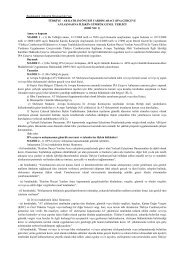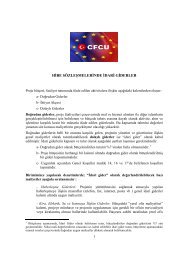Project Cycle Management Training Handbook - CFCU
Project Cycle Management Training Handbook - CFCU
Project Cycle Management Training Handbook - CFCU
You also want an ePaper? Increase the reach of your titles
YUMPU automatically turns print PDFs into web optimized ePapers that Google loves.
<strong>Project</strong> <strong>Cycle</strong> <strong>Management</strong> <strong>Training</strong> <strong>Handbook</strong><br />
Communication<br />
& feedback!<br />
6.2.4 Reporting<br />
Information needs must be related to levels of management, and<br />
selection of indicators should reflect this through the specification<br />
of a minimum set of information. More detail is required at the<br />
day-to-day operational level, while aggregated and summarised<br />
data is used at higher levels.<br />
♦ selection of overly-complex indicators which present major<br />
problems for data collection, either in terms of the skills or the<br />
resources required. Qualitative indicators are also a means of<br />
conveying complex information in summarised form.<br />
♦ over-concentration on progress indicators which provide<br />
insufficient information on the performance of the project. A<br />
common response to such a criticism is that it is not possible to<br />
measure impact during the lifetime of a project. However, by using<br />
leading indicators 8 , it should be possible to gain a clear indication<br />
of the likelihood of achieving objectives - if clients are satisfied<br />
with the services being provided by the project, then it is likely that<br />
they will continue to utilise these services and therefore that this<br />
change in their behaviour will translate into real benefits in the<br />
longer term. Selection of impact indicators is a critical part of<br />
project design and can in fact sharpen definition of objectives and<br />
identification of intended clients. It should form an important focus<br />
for early discussions between project partners.<br />
<strong>Project</strong> managers will want to review progress very frequently,<br />
perhaps weekly or fortnightly, against their contracted budget and<br />
planned activities. Much of this data will be of an operational nature<br />
for internal use by the project team. A few selected items, plus<br />
aggregated data on equipment and materials, are considered ‘key’<br />
indicators for reporting in the progress reports.<br />
Monitoring cannot be described as being successful simply because<br />
the required information is collected. The information collected must<br />
be communicated - in the right form, to the right person, at the right<br />
time. Only then can timely and appropriate management decisions be<br />
made to address problems and ensure that the project is brought ‘back<br />
on track’.<br />
8 A leading indicator is a proxy or substitute for an impact indicator.<br />
59





